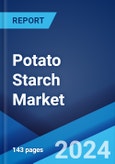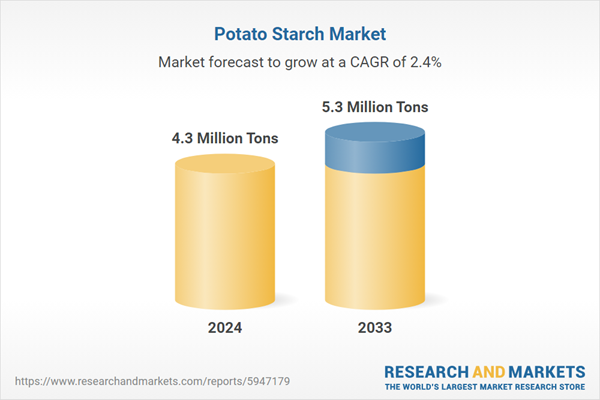Potato starch is a refined white powder derived from the processing of potatoes. One of its primary uses is as a thickening agent in culinary applications, including soups, sauces, and gravies. Its ability to provide a smooth, clear texture to these dishes makes it a popular choice. Moreover, potato starch offers several advantages, including gluten-free status, making it suitable for individuals with gluten sensitivities or celiac disease. It also exhibits good freeze-thaw stability, making it ideal for frozen food products. There are two main types of potato starch: native and modified. Native potato starch is extracted through a simple mechanical process, while modified potato starch undergoes chemical alterations to enhance its functionality in specific applications. These types cater to a wide range of industries, such as food, pharmaceuticals, and textiles, emphasizing the significance of potato starch in various sectors.
The global potato starch market is influenced by the increasing consumer demand for gluten-free and clean-label products and the rise in vegan and vegetarian diets. This is further augmented by the growth of the food processing industry. Moreover, the expanding applications of potato starch in various industries, such as textiles and pharmaceuticals, and the shifting focus on sustainable and eco-friendly production methods are accelerating market growth. In line with this, the expanding convenience food sector and the emergence of innovative potato starch products are propelling market growth. Furthermore, rising health consciousness among consumers and the globalization of food supply chains are fueling the market growth.
Potato Starch Market Trends/Drivers
Increasing consumer demand for gluten-free and clean-label products
The global potato starch market is significantly influenced by the surging consumer demand for gluten-free and clean-label products. Consumers today are increasingly health-conscious and are seeking alternatives to traditional wheat-based ingredients. Potato starch, being naturally gluten-free, has gained prominence as a preferred choice in various food products. This demand is propelled by individuals with gluten sensitivities, celiac disease, and those adopting gluten-free diets for perceived health benefits. Clean-label products are another driving force. Consumers are scrutinizing product labels more than ever, seeking transparency in ingredient sourcing and processing. Potato starch, a minimally processed ingredient derived from potatoes, aligns with these preferences. It's considered a clean and natural ingredient, making it an attractive option for food manufacturers aiming to meet consumer demands for transparency and simplicity in food products. This dual demand for gluten-free and clean-label products positions potato starch as a pivotal component in the evolving food industry landscape.Rise in vegan and vegetarian diets
The global shift toward plant-based diets, including vegan and vegetarian lifestyles, is a significant driver shaping the potato starch market. As more individuals adopt these dietary choices for health, ethical, and environmental reasons, the demand for plant-based ingredients has soared. Potato starch, being plant-derived, is a versatile ingredient that aligns perfectly with this trend. Potato starch serves as a key component in plant-based meat substitutes, dairy alternatives, and a wide range of vegan and vegetarian-friendly food products. It enhances texture, provides binding properties, and contributes to the overall quality of plant-based foods. As the popularity of plant-based diets continues to grow, the potato starch market is poised for sustained expansion. This driver not only caters to changing consumer preferences but also underscores the market's adaptability and responsiveness to evolving dietary trends.Growth of the food processing industry
The food processing industry's rapid expansion is a pivotal driver influencing the global potato starch market. Food manufacturers across the world are continually innovating to meet the demand for convenience foods, snacks, and processed products. Potato starch finds extensive application in this sector due to its versatile functional properties. In food processing, potato starch serves as a thickening agent, texturizer, and stabilizer, contributing to the desired texture and mouthfeel in a wide array of products. The growth in the demand for processed foods, snacks, and ready-to-eat meals drives the need for potato starch as an essential ingredient. Moreover, the expanding global population and urbanization further fuel this growth, as consumers seek convenient food options. Consequently, the continued expansion of the food processing industry is a key driver that underlines the significance of potato starch in the global market.Potato Starch Industry Segmentation
This report provides an analysis of the key trends in each segment of the global potato starch market report, along with forecasts at the global and regional levels from 2025-2033. The report has categorized the market based on category and application.Breakup by Category
- Native Starch
- Modified Starch
- Sweeteners
The report has provided a detailed breakup and analysis of the market based on the category. This includes native starch, modified starch, and sweeteners. According to the report, native starch represented the largest segment.
The growth of the native starch segment is primarily propelled by the increasing awareness and preference for natural and unmodified ingredients in the food and beverage industry. Consumers are seeking products with minimal processing and additives, which aligns with the 'clean label' trend. In line with this, the expanding application scope of native starch in various industries, including pharmaceuticals, textiles, and paper manufacturing, is boosting its market growth. Additionally, the rising demand for gluten-free and allergen-free ingredients is fueling the adoption of native starch, as it inherently lacks the modifications and additives often present in modified starches. Furthermore, the growing awareness of sustainable and eco-friendly production practices is favoring native starch, as its production typically involves fewer chemical processes compared to modified starches.
Breakup by Application
- Food Applications
- Industrial Applications
The report has provided a detailed breakup and analysis of the market based on the application. This includes food applications and industrial applications. According to the report, food applications represented the largest segment.
The growth of the food applications segment in the potato starch market is primarily driven by the increasing demand for gluten-free and clean-label food products, which has led to a higher adoption of potato starch as a versatile ingredient in various food applications. Moreover, the rise in consumer awareness about health and nutrition has spurred the use of potato starch as a natural and non-allergenic thickening, stabilizing, and texturizing agent. In line with this, the global shift toward plant-based diets, including vegan and vegetarian lifestyles, has further boosted the demand for potato starch as it plays a crucial role in enhancing the quality and texture of plant-based foods. Additionally, the expansion of the convenience food sector, driven by busy lifestyles, has led to a greater reliance on potato starch for its functional properties in ready-to-eat and processed food products. Furthermore, ongoing innovations in food formulations and the development of new potato starch-based products have also contributed to the growth of this segment, making potato starch a versatile and indispensable ingredient in the food industry.
Breakup by Region
- Europe
- Asia Pacific
- North America
- Latin America
- Middle East and Africa
The market research report has also provided a comprehensive analysis of all the major regional markets, which include Europe, Asia Pacific, North America, Latin America, and the Middle East and Africa. According to the report, Europe accounted for the largest market share.
The growth of the potato starch market in Europe can be attributed to the increasing consumer preference for gluten-free and clean-label products, which has fueled the demand for potato starch as a natural, gluten-free ingredient, aligning with consumers' health-conscious choices and clean-label preferences. In line with this, the region's strong inclination towards sustainability has propelled the use of potato starch as an eco-friendly alternative, contributing to its market growth. Additionally, the rise in vegan and vegetarian diets in Europe has driven the need for plant-based ingredients, where potato starch plays a vital role in enhancing the quality and texture of various meat and dairy alternatives. Furthermore, the well-established food processing industry in Europe, with its continuous innovation and product development, has provided a significant platform for potato starch utilization, solidifying its presence in the market. Apart from this, the European market's responsiveness to evolving dietary trends, coupled with a focus on convenience foods, has amplified the demand for potato starch as a versatile ingredient, further contributing to its growth trajectory in the region.
Competitive Landscape
The competitive landscape of the global potato starch market is characterized by a dynamic and evolving environment, marked by several key factors. Market players, both established and emerging, engage in strategic initiatives to gain a competitive edge. These strategies encompass product development, capacity expansions, and collaborations to cater to the growing demand for potato starch in various industries. Additionally, investments in research and development are driving innovations in potato starch applications, leading to the introduction of novel products.Market participants are also focusing on sustainability and eco-friendly production methods, aligning with the growing environmental consciousness among consumers. Moreover, geographical expansion and market penetration are key aspects of competition, as companies seek to tap into new and emerging markets. The regulatory landscape plays a crucial role in shaping the competitive dynamics, as compliance with food safety and labeling regulations is imperative. Furthermore, pricing strategies, supply chain management, and distribution networks are critical elements in maintaining competitiveness in this market.
The report has provided a comprehensive analysis of the competitive landscape in the market. Detailed profiles of all major companies have also been provided. Some of the key players in the market include:
- Avebe
- Emsland Group
- KMC
- Roquette
- Ingredion Incorporated
Key Questions Answered in This Report
1. How big is the global potato starch market?2. What is the expected growth rate of the global potato starch market during 2025-2033?
3. What are the key factors driving the global potato starch market?
4. What has been the impact of COVID-19 on the global potato starch market?
5. What is the breakup of the global potato starch market based on the category?
6. What is the breakup of the global potato starch market based on the application?
7. What are the key regions in the global potato starch market?
8. Who are the key players/companies in the global potato starch market?
Table of Contents
Companies Mentioned
- Avebe
- Emsland Group
- KMC
- Roquette
- Ingredion Incorporated
Methodology

LOADING...
Table Information
| Report Attribute | Details |
|---|---|
| No. of Pages | 149 |
| Published | February 2025 |
| Forecast Period | 2024 - 2033 |
| Estimated Market Value in 2024 | 4.3 Million Tons |
| Forecasted Market Value by 2033 | 5.3 Million Tons |
| Compound Annual Growth Rate | 2.4% |
| Regions Covered | Global |
| No. of Companies Mentioned | 5 |









